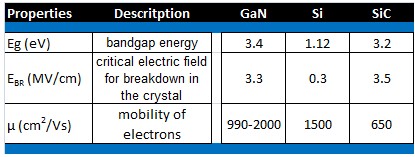GaN sailing
Gallium Nitride (GaN) transistors, specifically HEMT (High Electron Mobility Transistor), made their debut in 2004 when Eudyna of Japan introduced a depletion RF transistor. By leveraging gallium nitride on silicon carbide substrates, Eudyna successfully developed transistors for the RF market. The HEMT structure relies on a two-dimensional electron gas (2DEG) formed at the interface of AlGaN and GaN heterostructures, which enables high electron mobility. This innovation allowed Eudyna to achieve significant power gain in the gigahertz frequency range.
In 2005, Nitronex launched the first depletion-type RF high-transmission transistor, fabricated using its SIGANTICTM technology on silicon-based GaN wafers. As more companies entered the market, GaN RF transistors continued to evolve, but their adoption outside the RF domain remained limited due to high costs and the complexity of operating depletion-mode devices.
In June 2009, EPC introduced the first enhanced silicon-based gallium nitride (eGaN®) field-effect transistor (FET). Designed to replace traditional power MOSFETs, eGaN FETs could be manufactured at scale using standard silicon fabrication techniques, making them cost-effective and scalable.
When evaluating power semiconductor devices, the key factors are performance, reliability, ease of control, and cost. Any new device must meet these criteria to be commercially viable.
Let’s compare silicon, silicon carbide, and GaN as next-generation power device platforms. Why choose GaN?
Silicon has dominated power semiconductors since the 1950s, offering four main advantages: driving new applications, proven reliability, ease of use, and cost-effectiveness. For a new material to replace silicon, it must outperform it in all these areas.
The strengths of silicon are rooted in its physical properties and the massive investments in manufacturing infrastructure. Now, let's look at some basic properties of silicon and how they compare with other alternatives. Table 1 shows the three main electrical properties of the three competing semiconductor materials used in power management systems.

Table 1: Comparison of properties of gallium nitride, silicon carbide, and silicon materials
To evaluate the performance of power transistors, we can compare the theoretical maximum performance based on fundamental crystalline parameters. Several key features influence power conversion systems, including conduction efficiency, breakdown voltage, switching speed, size, and cost. These characteristics determine the system’s frequency and power density.
From Table 1 (adjusted for GaN’s high two-dimensional electron gas mobility), we can calculate the theoretical minimum resistance as a function of breakdown voltage and material. Both SiC and GaN have higher critical electric fields than silicon, resulting in better resistance-breakdown voltage trade-offs. This allows for smaller devices at the same breakdown voltage and closer terminal spacing.
Additionally, GaN offers an advantage over SiC because of its higher electron mobility, allowing even smaller devices for the same resistance and breakdown voltage. This makes GaN a more compact solution.
Since GaN devices are significantly smaller than silicon ones and have higher electron mobility, GaN HEMTs can switch faster. Figure 2 illustrates the switching time of a 12V to 1.2V buck converter using a GaN transistor and two silicon power MOSFETs. The GaN transistor switches five times faster than a 40V silicon device and four times faster than a 25V silicon device. This further highlights the benefits of GaN technology.
truck accessories,ford truck parts,volvo truck parts,truck parts online,
YIWU JINGHONG AUTO PARTS CO.,LTD , https://en.jhauto.ru